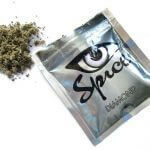Understanding Synthetic Marijuana (Spice, K2, Mojo)
Synthetic marijuana, also called Spice, K2 or synthetic cannabinoids, is a chemically modified herbal substance that produces mind-altering effects similar to or more potent than marijuana. The chemicals in synthetic marijuana are manufactured to be similar to tetrahydrocannabinol (THC), the psychoactive ingredient in marijuana. Spice is most commonly smoked, though it may be prepared in drinks or edibles.
According to the DEA, most of the chemicals used in synthetic marijuana are manufactured in Asia with no regulations or standards. They are then smuggled to the U.S. where they are sprinkled on plant material and packaged. Some of these chemicals are legal, though there have been more and more illegal compounds found in synthetic marijuana. In 2015, the DEA listed 15 variants of synthetic marijuana as Schedule I substances, meaning they are treated as the same category of drugs as crack cocaine and heroin. Also, the FDA noted that over 75 other compounds have been identified that are not currently controlled. These chemicals range greatly in safety and are not all recommended for consumption.
Sold in gas stations, head shops and on the internet, this drug is promoted as a “safe” and legal alternative to marijuana despite significant evidence to the contrary. Synthetic marijuana is marketed as incense or potpourri and labeled as “not for human consumption.” This marketing loophole allows the substance to be sold legally.
The packaging, name and ingredients of synthetic marijuana are inconsistent and vary based on the seller. Because of this, the drug is a moving target for both health officials and police enforcement hoping to cut down on its negative effects.
Spice and K2 are the most common names for the synthetic drug. Other names include:
- Mojo
- Black Mamba
- Genie
- Cloud 9
- Yucatan Fire
- Moon Rocks
- Skunk
- Zohai
- Bliss
- Blaze
- Fake Weed
If someone you know or care about is abusing synthetic marijuana, get help today.
Synthetic Marijuana Abuse and Effects
Because synthetic marijuana is not officially intended to be smoked or ingested, using it in any form is considered abuse.
Many teenagers and young adults are drawn to synthetic marijuana because they inaccurately believe it is safer than marijuana—or that they won’t get in trouble for using it because it can be purchased legally. Synthetic marijuana doesn’t show up on most drug tests, making the drug an attractive choice for those worried about getting caught.
The effects of synthetic marijuana are similar to those of marijuana. These include altered perception of reality and feeling relaxed and in a good mood. The actual ingredients in synthetic marijuana are different in every batch; the chemicals used to produce the substance’s effects were originally formulated to be used as anything from fertilizers to cancer treatments. These chemicals have not been approved for human consumption, and there is no way to know what adverse reactions a user may have.
Minor side effects of synthetic marijuana are similar to those of real marijuana. However, there have been many accounts of severe side effects from synthetic marijuana up to and including death.
Side effects of synthetic marijuana may include:
- High blood pressure
- Anxiety
- Nausea/vomiting
- Paranoia
- Seizures
- Rapid heart rate
- Profuse sweating
- Confusion
- Hallucinations
- Heart attacks
- Kidney damage
[Synthetic marijuana use] is not an epidemic. But it’s a growing problem. And people need to be thinking about it, and how we’re going to deal with it.
